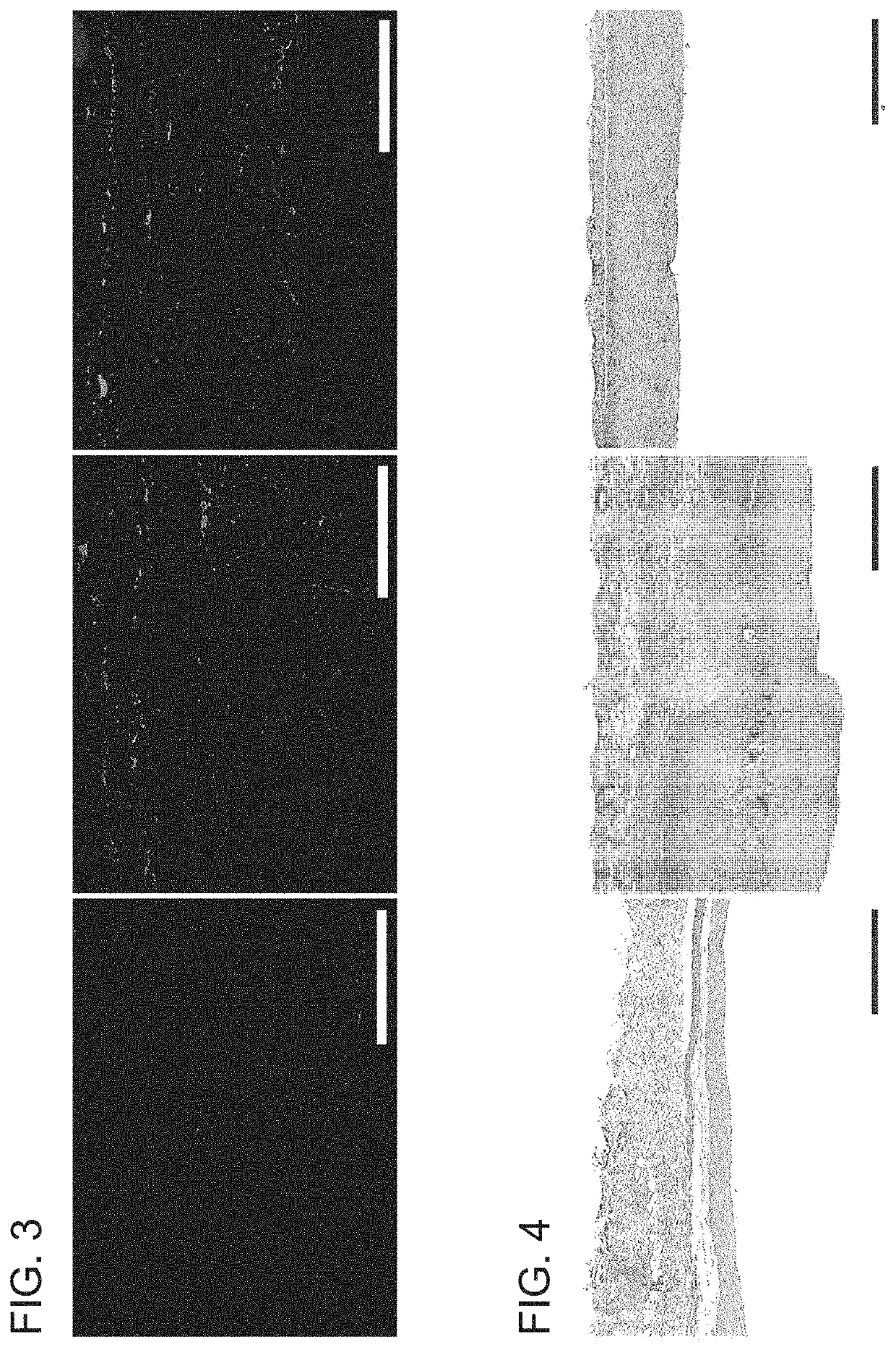Methods for tissue passivation
a tissue and passivation technology, applied in the field of tissue passivation, can solve the problems of affecting the quality of life of patients, the inability to achieve effective prevention methods of capsular contracture, and the deformation or rupture of the capsule, so as to prevent or reduce the stenosis, the effect of preventing or reducing the stenosis
- Summary
- Abstract
- Description
- Claims
- Application Information
AI Technical Summary
Benefits of technology
Problems solved by technology
Method used
Image
Examples
example 1
rface Passivation in a Rabbit Model for Capsular Contraction
[0122]A pilot experiment in a rabbit model for capsular contraction was developed. Three sub-cutaneous pockets were made by surgical incision on the upper rabbit flank. One pocket was left untreated and surgically closed (No fibrin glue). Of the remaining two, one was treated with Fibrin Glue only, and one received Fibrin Glue+RB (0.1% Rose Bengal)+532 nm light (3 min at 350 mW). Fibrin glue is known to produce a fibrotic reaction in this model. After two weeks all three pockets were surgically re-accessed and inspected. Tissue harvested at two weeks demonstrated an aggressive inflammatory response, with a significant infiltrate within the implant pockets instilled with fibrin glue (FIG. 1). The pockets treated with PTP prior to fibrin glue application, had less infiltrate. These cells also appear contained under layers of presumably, cross-linked collagen. A biodegradation assay was also performed. Pockets were treated as ...
example 2
rface Passivation in a Pre-clinical Model of Capsular Contracture Following Prosthetic Implant Placement
[0124]The effect of Photochemical Tissue Passivation in a pre-clinical model of capsular contracture following prosthetic implant placement was evaluated. Under general anesthesia, Nine New Zealand white rabbits received three, six cc smooth saline implants placed in the dorsal sub-panniculus soft tissue. Each Rabbit received one control implant and two experimental implants.
[0125]Briefly, the subpanniculus carnosus plane in the dorsum region was dissected and a single customized six cc saline smooth implant with pressure port valve (Allergan Inc., CA, USA) was placed. A total of three implants were placed on the dorsum of each rabbit. The control group consisted of an implant with no Fibrin Glue and no PTP treatment. Before implant placement, the pocket site of the PTP experimental group was treated with 2 ml 0.1% Rose Bengal in a phosphate buffered saline, and was then exposed t...
example 3
ical Tissue Passivation for Prevention of Vein Graft Intimal Hyperplasia
[0132]Vein grafts are frequently used for Coronary Artery Bypass Grafting yet suffer poor long-term patency rates compared to arterial grafts due to accelerated atherosclerosis. This begins as intimal hyperplasia (IH), which is a consequence of intimal injury resulting from surgical trauma and excessive dilation of the vein graft as it is exposed to arterial pressures. Limiting this stretch reduces the degree of IH. To date, this has only been achieved with external sheaths. Photochemical Tissue Passivation (PTP) was conducted to determine whether this procedure could improve the long-term patency rates of venous grafts.
[0133]Porcine jugular veins were used to evaluate the effect of PTP on the elasticity of venous tissues. Veins harvested from five pigs were divided in half. One segment served as control, the other was treated (PTP) with 0.1% Rose Bengal and a 532 nm laser (delivering 25 J / cm2). Veins were cut i...
PUM
 Login to View More
Login to View More Abstract
Description
Claims
Application Information
 Login to View More
Login to View More - R&D
- Intellectual Property
- Life Sciences
- Materials
- Tech Scout
- Unparalleled Data Quality
- Higher Quality Content
- 60% Fewer Hallucinations
Browse by: Latest US Patents, China's latest patents, Technical Efficacy Thesaurus, Application Domain, Technology Topic, Popular Technical Reports.
© 2025 PatSnap. All rights reserved.Legal|Privacy policy|Modern Slavery Act Transparency Statement|Sitemap|About US| Contact US: help@patsnap.com



